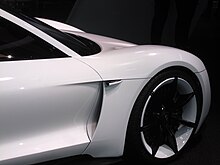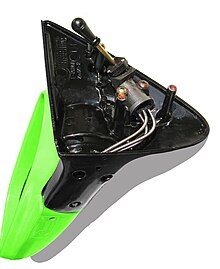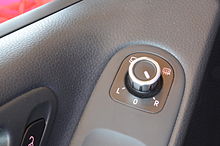Rearview mirror
A rearview mirror is a reflective surface that is designed to make it easier to observe the traffic behind you and to make driving a vehicle safer.
The aim is to make as large an area as possible behind the vehicle visible. Therefore, convexly curved mirrors are often used, which, however, depict this area in a somewhat reduced size.
In principle, a distinction is made between inside and outside mirrors in vehicle mirrors .
history
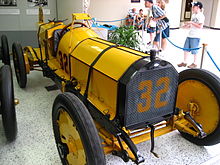
The two steam cars from the Australian manufacturer JAC Ziegler had a rear-view mirror so that the driver could observe the water level indicator of the boiler, which was located under the back seat. Depending on the source, the year of construction is either 1898 or 1905.
One of the earliest thoughts on the rearview mirror was published in 1906 by the Englishwoman Dorothy Levitt . In her work "The Woman and the Car" she wrote:
"Women should carry a small hand mirror under the driver's seat and take it up from time to time to look back while driving in traffic."
The first permanently installed rearview mirror was installed on his racing car by American racing driver Ray Harroun in 1911 at the 500-mile race in Indianapolis . This saved the space for the front passenger, who previously had to give the driver information about what was happening behind. Due to the reduced weight of the car, Ray Harroun won.
The first vehicle manufacturers installed rear-view mirrors on automobiles from 1914, so u. a. the Model T Ford . In the Ruhr area , which was occupied by France and Belgium in 1923 due to the lack of reparations, the "rearview mirror" was placed on the side of the truck by order.
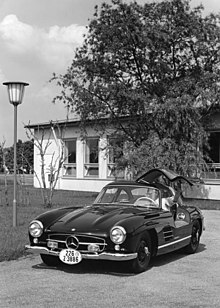
History in Germany
In the regulation on motor vehicle traffic (the forerunner of the StVZO) of December 5, 1925, the provision was inserted in § 4 (8) that "trucks on the left side" must have a mirror. The first StVZO from 1937 (came into force on January 1, 1938) said in Section 56 about rear-view mirrors: "Motor vehicles, except motorcycles and open electric carts, must have a mirror of sufficient size and type of attachment for rearward observation of the road. "Where the rear-view mirror was to be attached resulted from the implementation instruction, which saw" a sufficient effect in closed vehicles only if the rear window was of the appropriate size ". Three-wheel delivery vans up to 250 cm³ displacement were exempt from the mirror requirement. With the amendment to the StVZO of April 9, 1956, Section 56 (1) stipulated that motor vehicles must have “inside and outside mirrors” “which are designed in such a way that the driver of the vehicle can observe all traffic processes that are essential for him backwards. […] A rear-view mirror is sufficient for motorcycles. ”This regulation came into force on November 1, 1956. Up to January 1, 1990, “a compulsory second exterior mirror was only required on vehicles in which the rearward view of the road through interior mirrors is not possible or only possible when the vehicle is unloaded.” The current Section 56 of the StVZO writes for all vehicles “mirrors or other devices for indirect vision ", so that the driver of the vehicle can" backwards, to the side and directly in front of the vehicle [...] observe all traffic processes that are essential for him ".
Inside mirror
Interior mirrors are useful where it is possible to see through the vehicle to the rear, i.e. in cars with a rear window. Interior mirrors are also installed in buses , but they serve to keep the passengers in view. In newer cars, the interior mirror is usually glued to the windshield and can be individually adjusted to the driver using a ball joint .
Dimming functions
Interior mirrors can usually be dimmed to avoid glare in the dark; they can be tilted into a position in which the light from the mirror glass is refracted in such a way that only a smaller part is reflected to the viewer without changing the field of vision.
With automatically dimming interior or exterior mirrors, two LDR sensors installed in the interior mirror measure the difference in brightness between the area in front of the car and the traffic area behind. Evaluation electronics then darken the mirror, which is made of electrochromic glass , if necessary so that the dazzling effect of the traffic behind is canceled.
Electronic interior mirror
Audi has announced an electronic rearview mirror for the R8 e-tron , which will be produced in small series from the end of 2012. The digital inside mirror is a display with a screen diagonal of 7.7 inches and a horizontal resolution of 1280 pixels in AMOLED technology, which reproduces the images of a rear camera and is to be produced by Samsung .
It is also installed as an optional feature in the production model of the Audi etron.
More functions
- If a vehicle has rain sensors or automatic light systems , these are often attached to the rear of the mounting point of the interior mirror and react either to raindrops or darkness.
- In modern taxis, a remote display with the fare display of the taximeter is often integrated in the interior mirror.
- For the aftermarket, there are display solutions for navigation devices that are integrated into the mirror surface of the interior mirror.
- In the USA in particular, an electronic compass integrated into the rearview mirror is popular, as there address names are often related to the orientation of a street.
- For upscale vehicle equipment, there are interior mirrors that measure the current alignment via engine or sensor combinations and can restore stored positions, for example depending on the memory function or vehicle key.
- When using a rear-facing baby seat on the rear seat, the child's face can be observed via the inside mirror in combination with a baby seat mirror .
Exterior mirrors

The exterior mirrors or side mirrors are on the left and right of the vehicle facing outwards and result in the largest width of the vehicle. However, the mirrors are not taken into account when specifying the vehicle width in the vehicle registration document. For practical reasons they are now often foldable; they can be folded up and must be brought into position again for use. The mirror setting used to be changed by hand on the mirror. Today almost all motor vehicles are offered with exterior mirrors that can be adjusted mechanically or electrically from the inside. With the mechanical adjustment there is a small joystick for each mirror , which controls the mirror via three Bowden cables . With the electrical adjustment, both mirrors can be adjusted with setting switches. The design of the mirror is also important in reducing the car's value . Exterior mirrors increase the value by 2 to 5 percent.
According to Section 56 (1) StVZO, when a trailer is operated that is wider than the towing vehicle, the attachment of mirrors with a longer projection is mandatory. The mirrors are to be attached vibration-free . For this reason, additional close-range mirrors are often necessary for trucks in order to ensure a direct view in front of or to the side of the vehicle.
Electrically heated exterior mirrors are offered.
blind spot
The area that cannot be seen by the interior and exterior mirrors is called the blind spot . In order to improve the rear view, cameras can be used, the image of which the driver can see on a screen.
Wide-angle mirrors on motor vehicles
Wide-angle mirrors have been commercially available as accessory parts for many years . They enlarge the driver's field of vision. Such mirrors, which are often already installed ex works in modern vehicles, usually offer a second viewing area in a separate area next to the conventional mirror, in which, compared to the "normal" view in the mirror, a larger section of the side is reduced and rear traffic is shown. These additional devices can be found on exterior mirrors and, in the case of cars, in some cases on interior mirrors. In addition to the divided second viewing windows, there are also one-piece mirrors with a wide-angle component, which, however, then require a distortion compared to normal perception in order to enlarge the area shown.
Since 2005, additional wide-angle mirrors have been stipulated across the EU for new model series on trucks . Since January 2007 all new trucks have to be equipped with additional wide-angle and close-range mirrors. From March 2009, retrofitting is mandatory for all vehicles registered before January 1, 2000 with a gross vehicle weight of 3.5 t or more.
Reversing or parking automatic
The so-called reversing or reverse gear or automatic parking system lowers the mirrors into an optimal position for parking or maneuvering and thus offers a better overview, e.g. B. regarding the curbs .
Electronic exterior mirror

From 2019 the Audi e-tron will be offered with an electronic rear-view mirror (optional, at an additional cost).
More functions
Lane change assistants are an additional safety plus . They support the driver when changing lanes, for example from a speed of 60 km / h. The area next to the moving vehicle is monitored and the driver is informed via an optical signal in the exterior mirror when the system has detected another vehicle in the next lane.
A special type of rearview mirror can be found in various sports cars, for example the Isdera Imperator 108i : the driver looks to the rear via a periscope-like mirror system attached to the roof . This vehicle has no side mirrors.
See also
literature
- Hans-Hermann Braess, Ulrich Seiffert: Vieweg manual automotive technology. 2nd edition, Friedrich Vieweg & Sohn Verlagsgesellschaft mbH, Braunschweig / Wiesbaden 2001, ISBN 3-528-13114-4 .
Web links
- Section 56 StVZO (Road Traffic Licensing Regulations): mirrors and other devices for indirect vision
Individual evidence
- ↑ George Nick Georgano (Editor-in-Chief): The Beaulieu Encyclopedia of the Automobile. Fitzroy Dearborn Publishers, Chicago 2001, ISBN 1-57958-293-1 , p. 1786. (English)
- ↑ Tony Davis: Aussie Cars. A Pedr Davis Production . Marque Publishing Company, Hurstville 1987, ISBN 0-947079-01-7 , pp. 18 (English).
- ^ Leonard JK Setright: The Guinness Book of Car Facts and Feats. Guinness Superlatives, Enfield 1980, ISBN 0-85112-207-8 , p. 35.
- ^ Motorsports Hall of Fame of America
- ↑ Stefan Weißenborn: "Looking back from time to time" - 100 years ago the first everyday cars with a rearview mirror were delivered. Allgemeine Zeitung Mainz of November 29, 2014, p. 57.
- ↑ Klaus Rabe: The beginning of all vice. Westermann, 1985, ISBN 3-07-508991-5 , pp. 47-48.
- ↑ Ordinance on motor vehicle traffic of December 5, 2015, in: Stilke´s Rechtsbibliothek No. 44, Berlin, 1926, p. 449.
- ^ Road traffic law, Beck Verlag, 1941, p. 120
- ↑ BGBl. I 1956, p. 203.
- ^ Peter Hentschel : Road traffic law . CHBeck Verlag Munich, 38th edition 2005, ISBN 978-3-406-52996-2 , p. 1195.
- ↑ See § 56 StVZO
- ↑ How the manual dimming mirror works
- ↑ heise Autos: Audi brings the "electronic rearview mirror" in small series August 14, 2012
- ^ Bosch: Kraftfahrtechnisches Taschenbuch. 24th edition 2002, ISBN 3-528-13876-9 , p. 795.
- ↑ heise online : Audi: Virtual exterior mirror for the first time in a production vehicle January 11, 2019







